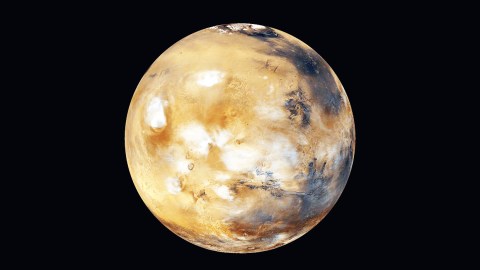More Evidence Points to Possible Martian Life — This Time in the Soil

Mars may seem like a desolate wasteland, but we’re finding more and more evidence that it might have life. That life, alive or extinct, is most likely in water. New analyses of data gathered by the 2001 Mars Odyssey rover reveals that water molecules are bound up in the very soil of Mars.
The key to all life as we know it, scientists have observed water on Mars’s surface before as ice on its poles. Now, knowing that water is an elemental part its soil may hold the key to terra forming it.
A study published in the Journal of Geophysical Research: Planet found iron sulfates in Martian soil that were chock full of chemically bonded water molecules, meaning water was trapped inside the iron sulfate molecules and helped hydrate Martian soil — which could have helped sustain life.
An iron sulfate molecule with bonded H2O.
The rover was able to learn this thanks to an on-board Gamma Ray Spectrometer. The spectrometer analyzed the composition of Mars’ ground while the rover orbited the planet. It analyzed Martian soil to a depth of 0.5 meters (1.6 feet), which is deeper than any other orbiter or robotic explorer has gotten.
All of that data helped the team learn that Mars’ southern hemisphere was richer in hydrated iron sulfates than the northern one. They also discovered that soil was more hydrated at lower southern latitudes and higher northern latitudes. “Soil thickness, ice presence and depth, atmospheric circulation, and sunshine can explain the current difference in the amount of water in the soil of different regions,” as IFL Science reports.
“The depth and breadth of these observation methods tell us about global significance, which can inform the big question of what happened to the hydrologic cycle on Mars,” said Professor Suniti Karunatillake, co-author of the study.
Scientists believe Mars once had more water on its surface than Earth’s Arctic Ocean. But without an atmosphere, that water escaped into space. During future space missions, astronauts could conceivably extract water vapor from the soil by heating the iron sulfate. Or by using what amounts to a dehumidifier:
IFL Science reports the team “has previously shown the association between sulfur and water,” so they were able to estimate the hydration of Mars’ soil from that data. Heritage Daily explains research: “Previous observations of soil observed along crater slopes on Mars showed a significant amount of perchlorate salts, which tend to be associated with brines with a moderate PH level.” While this current study builds on that research, there are no definitive conclusions as to why or how the iron sulfates became chemically bonded to water molecules.
The team has theories, though. They range from hydrothermal activity, acid fog from extinct volcanos, and even efflorescence, which is how salt deposits form in basements or on brick walls. The most likely of these theories are hydrothermal activity and acid fog. Hydrothermal activity generates sulfate-rich hydrated mineral deposits along volcanoes, similar to the soil surrounding Hawaiian volcanoes. Acid fog would be “dispersed throughout the atmosphere, and interacting subsequently with the finer components of soil as a source of widespread hydrated iron-sulfate salts,” according to Heritage Daily. As likely as both of these scenarios seem, the spectrograph only measures elements rather than mineral composition, the team will need further research to be certain.
The findings are significant. “We’re excited about the new findings as it contributes to the story of water on Mars,” says co-author Nicole Button from Louisiana State University in a press release. These findings may also help us figure out how to survive on Mars — which may be a more pressing problem than you think. As of right now, NASA’s Space Launch System (SLS) rocket is halfway finished at the Kennedy Space Center. The SLS and the Orion spacecraft are being built specifically to get us to Mars. According to NASA “installation of the remaining five levels of platforms should be completed by spring 2017. Testing of the platforms will begin later this year.” Hopefully we’ll be able to figure out the water situation soon.
Credit: SLS Engine/NASA





